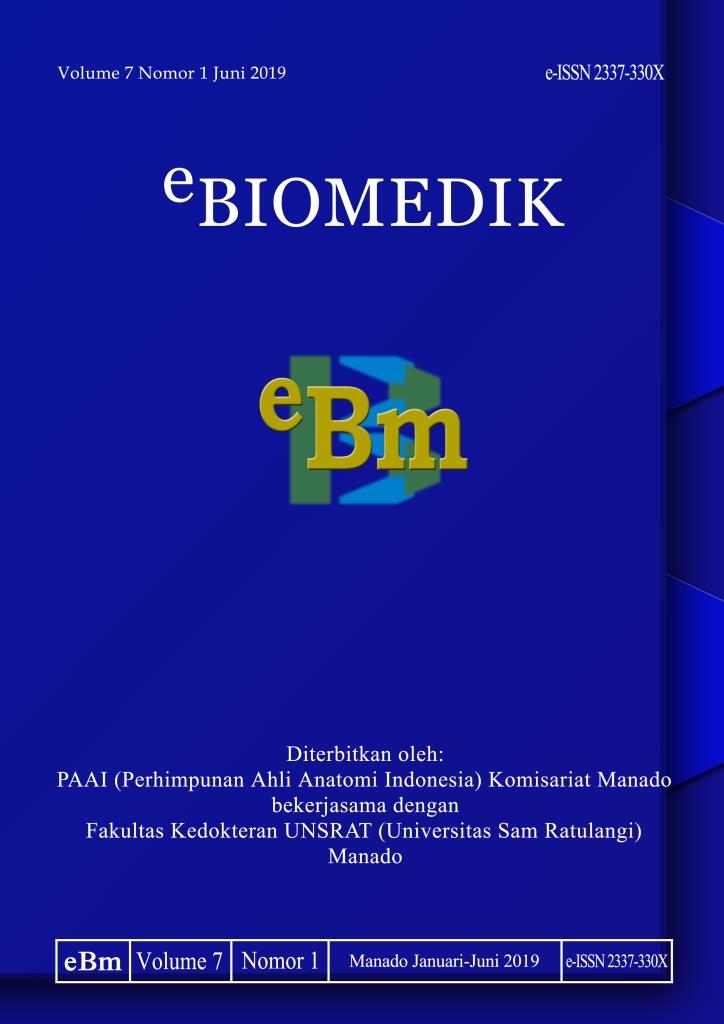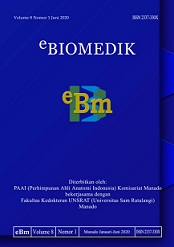Profil Resistensi Antimikroba dari Flora Normal dalam Kavum Nasi Petugas Kamar Operasi Bedah Jantung dan Petugas Pasca Operasi Intensive Coronary Care Unit RSUP H. Adam Malik Medan
DOI:
https://doi.org/10.35790/ebm.v7i1.23535Abstract
Abstract: Nosocomial infection often occurs in hospitalized patients due to microbial contamination. This study was aimed to obtain the profile of microbes in nasal cavities of hospital personnel by identification the microbial pattern, therefore, the microbial resistance to several antimicrobial groups could be determined. This was an observational analytical study with a cross sectional design. Subjects were hospital personnel at the Cardiac Surgery room and at the Intensive Coronary Care Unit (ICCU) room of H. Adam Malik General Hospital, Medan. Specimens of nasal cavity swabs were taken from all subjects, and then were cultured and tested for antimicrobial sensitivity. From 37 subjects, the most common bacteria found were S. epidermidis (40%), S. saprophyticus (21%), and S. aureus (12%). The antimicrobial susceptibility test showed that sufamethoxsazole had the highest resistance while erythomycin still had good sensitivity. At the ICCU room, amikacin showed better sensitivity than doxycyclin. Amoxiclav had the highest sensitivity, meanwhile from the floroquinolone class, norfloxacin had better sensitivity than ciprofloxacin. The microbes were still sensitive to cephalosporin class but were resistant to vancomycin. Conclusion: S. epidermidis, S. saprothyticus, and S. aureus were the most commonly found microbes in the nasal cavities of hospital personnel. The nasal cavity microbes were still sensitive to erythromycin, amikacin, amoxiclav, norfloxacin, and cephalosporin group.
Keywords: nosocomial infection, nasal cavity, antimicrobial resistance, antimicrobial sensitivity
Â
Abstrak: Infeksi nosokomial sering terjadi pada saat pasien dirawat di rumah sakit akibat adanya kontaminasi mikroba yang berada di rumah sakit. Penelitian ini bertujuan untuk mendapatkan pola mikroba kavum nasi dari petugas rumah sakit melalui identifikasi mikroba sehingga dapat ditentukan pola resistensi mikroba terhadap berbagai macam golongan antimikroba. Jenis penelitian ialah analitik observasional dengan desain potong lintang. Subyek penelitian ialah petugas di kamar operasi bedah jantung dan ruang pasca operasi ICCU di RSUP H. Adam Malik Medan. Pengambilan spesimen swab kavum nasi dilakukan pada semua subyek, dilanjutkan dengan pembiakan serta uji resistensi antimikroba. Dari 37 subyek didapatkan bakteri terbanyak yaitu S. epidermidis (40%), diikuti oleh S. saprothyticus (21%), dan S. aureus (12%). Uji sensitivitas terhadap antimikroba lini pertama mendapatkan sulfametoksasol merupakan antimikroba yang paling tinggi resistensinya sedangkan eritromisin merupakan antimikroba yang masih baik sensitivitasnya. Untuk ruang ICCU, sensitivitas terhadap amikasin masih lebih baik dibandingkan doksisiklin. Amoksiklav merupakan antimikroba yang sensitivitasnya sangat baik, sedangkan dari golongan florokuinolon, norfloksasin memiliki sensitivitas yang lebih baik dibanding siprofloksasin. Golongan sefalosporin masih memiliki sensitifitas yang baik, sedangkan vankomisin sudah resisten. Simpulan: Bakteri terbanyak didapatkan dalam kavum nasi ialah S. epidermidis, S. saprothyticus, dan S. aureus. Antimikroba yang masih sensitif yaitu eritromisin, amikasin, amoksiklav, norfloksasin, dan golongan sefalosporin.
Kata kunci: infeksi nosokomial, kavum nasi, resistensi antimikroba, sensitivitas antimikroba





